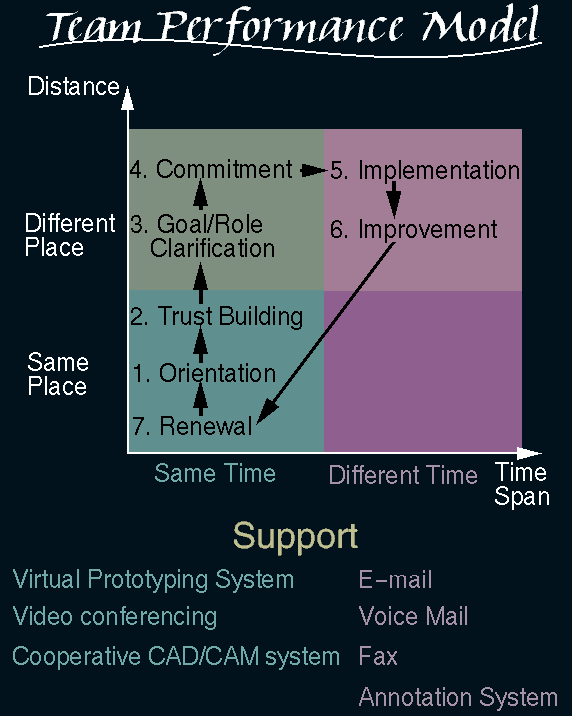
typically people work in groups which must cooperate.
Technology gives more opportunity for collaboration across time and distance
Time Space Matrix (Ellis et al 1991)
| Same Time (synchronous) | Different Time (asynchronous) | |
| Different Place | telephone, computer-mediated chat
video conferencing shared whiteboard shared PC windows |
letter, email |
| Same Place | face to face conversation
meeting rooms |
post-it note |
telephone is popular
email is popular
bulletin boards -> usenet newsgroups popular
videoconferencing is getting popular
programs like net meeting getting popular
popularity doesn't map directly onto 'success'.
- does email increase productivity?
- does videoconferencing reduce travel?
hard to perform studies

People are used to certain 'norms' in interpersonal communication. These can be social norms in how one acts in certain situations (how one acts as a student in a classroom, or talking to a co-worker, how one talks to a group of friends, or giving a presentation, even just the idea that you take turns during a conversation), concepts of personal space.
People are used to audio-only communication over the telephone.
New norms under these conditions.
No eye contact, no facial expressions -> less information
being transferred
Latency causes breakdown (duplex -> simplex)
Conference calls complicate things - who talks next?
-When we talk, we tend to stand with our heads a certain distance apart. Talking further apart seems somewhat uncomfortable, talking closer together seems very uncomfortable.
-Accept people being closer at our sides or behind than in front of us.
- Very culturally dependant
- hearing a person's voice version seeing their face
inclination of their head
facial expressions
eye-contact
- affects how video conferencing systems are setup
what should the camera see?
where should the camera and microphone be located?
do you look at the screen while talking into the microphone
is the camera always 'looking down' / 'looking up' at each person
how much resolution is needed?
how little latency is needed?
- gestures also important
physical gestures
position of the mouse on a screen
- back channels
not explicit
also give important information
shrugs, 'um's
- conversation
turn taking
listener requests the floor (verbally, gesturally, using a facial expression)
back channel is important here
speaker offers the floor (short gap in the conversation)
both can be very difficult if latency is high
working in groups is much more than a technological issue
social organization
harder to maintain hierarchy
when technology equalizes the participants
roles may change during the group activity
participants amy change during the group activity
in different group activities in a physical room there are different
room layouts
presentation / classroom where most of the people
look in one direction at the screen
and the presentor
meeting with the boss at the head of the table
round table discussion
is there a 'power position'? where is it?
that paper on the video wall that didnt work
next tuesday all 8 groups will turn in their storyboards at the beginning
of class on Tuesday - you need to convince me that you have thought through
the problem completely and come up with a reasonable design for the entire
system, so having some nice organization for the storyboards would be very
helpful to me.